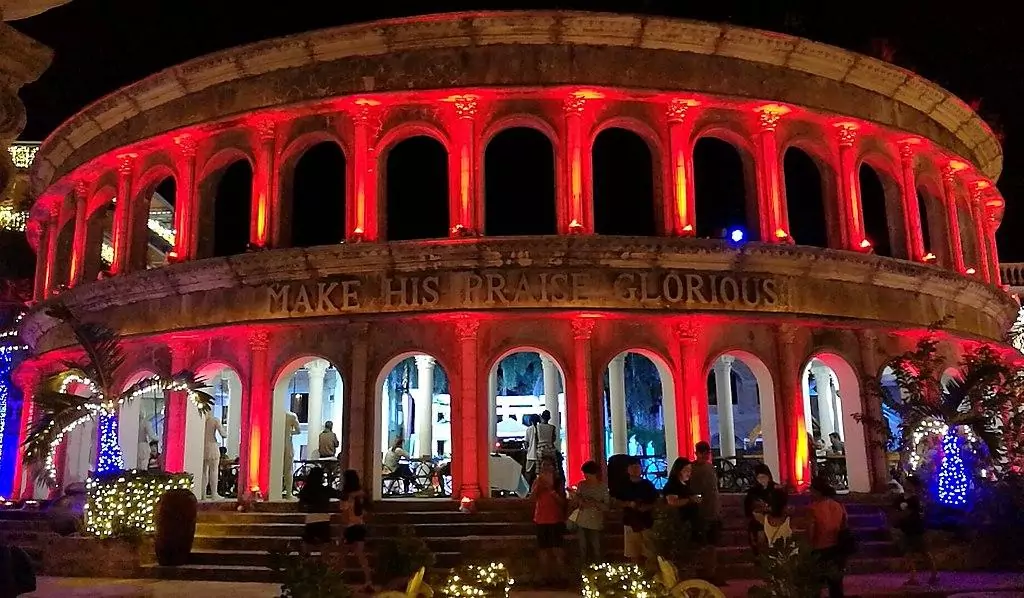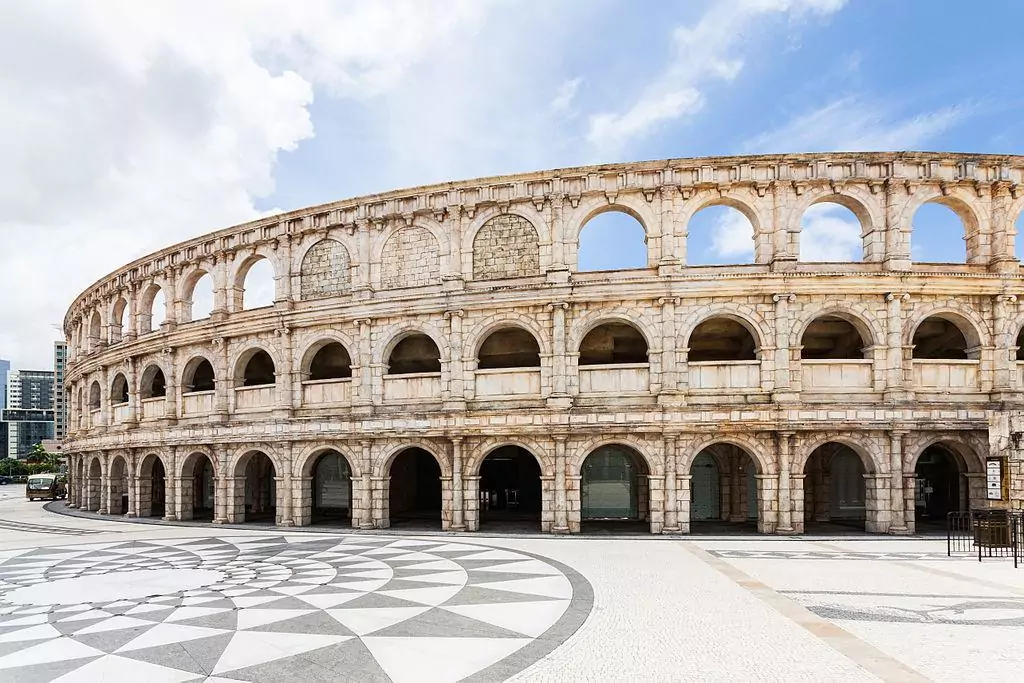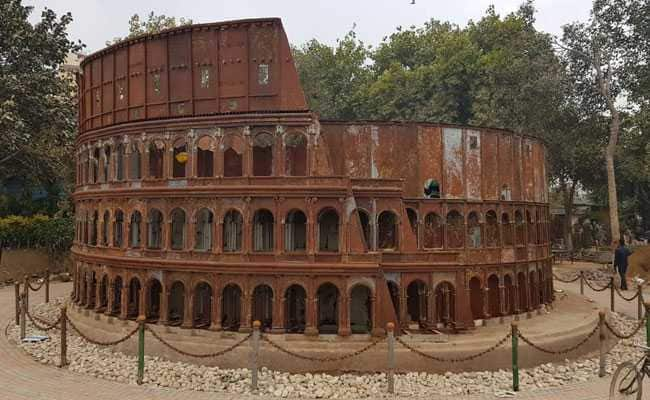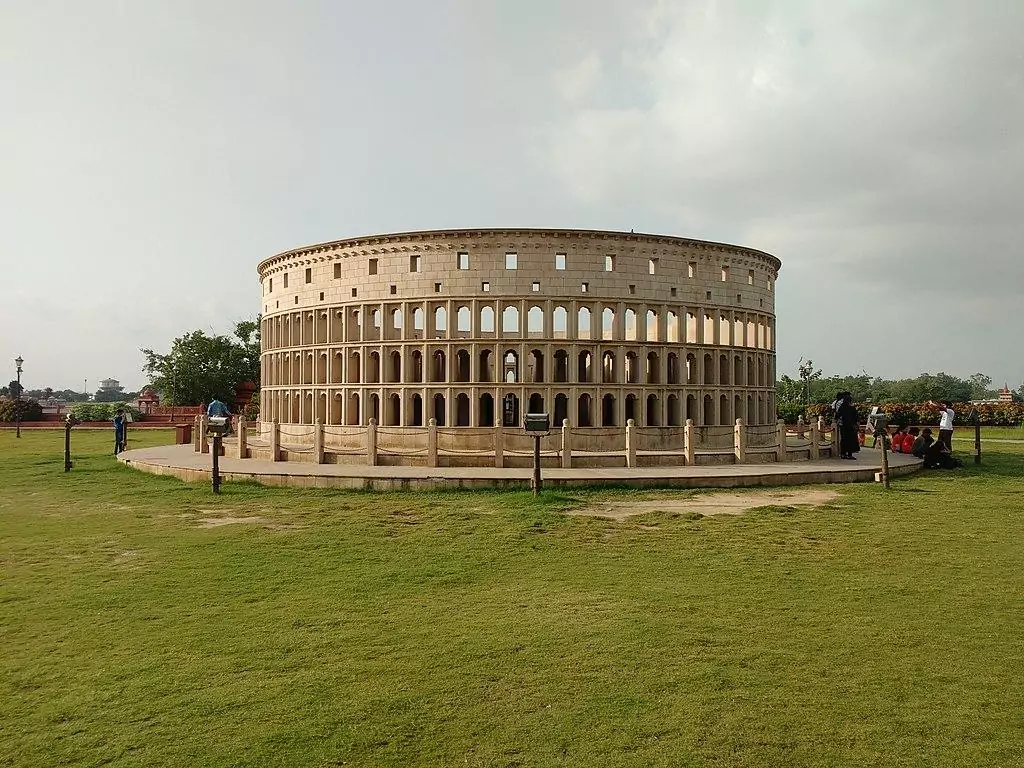
Listed as one of the New 7 Wonders of the World, the Colosseum in Rome is among history’s most recognizable man-made structures. Despite its advanced age of almost two millennia, this monument is still the world’s largest amphitheater. The Colosseum’s glorious status exceeds far beyond the boundaries of the Italian capital, so much so that this ancient landmark inspired tens of replicas all across the planet, including the following 8 pseudo-coliseums.
While Rome and the Philippine town of Bamban in Tarlac province are separated by more than 10,000 kilometers of land and sea, they both share a common feature, a Colosseum as their most notable landmark. Inaugurated in 2017 at the outskirts of town, the Goshen Resort and Hotel revolves entirely around ancient Roman architecture.
This 4-hectare complex abounds with Roman style sculptures, arches and Corinthian columns, yet its true centerpiece is a Colosseum-shaped colonnade, locally dubbed as “Dambana ni Yahweh”. Unlike its Italy-based twin, the replica is semi-circular and two-story tall, with the second level featuring a balcony along its half-circumference. A round staircase, embellished with columns and vases, welcomes visitors to the iconic frontage, which contains a sizable relief with the words “Make his Praise Glorious”, a reference to the region’s Catholic heritage.
In practice, Bamban’s Colosseum is merely a façade, with nothing but a paved square behind it. Nevertheless, it is enough to lure swarms of visitors, most of whom are Pinoys, who wish to have a glimpse of ancient Rome but can’t afford the trip.

Tarlac's Colosseum lit during the night
photography by: Bien Orellana Bacarra Jr/ Wikimedia Commons
Formerly a Portuguese colony, the special administrative region of Macau is often referred to as China’s Las-Vegas as it awash with outlandishly designed casinos. It should then come as no surprise that Macau is also home to its own Roman amphitheater. Stretching along the shoreline of the city’s Sé district, Macau Fisherman’s Wharf is a recently-built recreational complex, housing a large casino, a convention center, entertainment facilities as well as dozens of restaurants and shops.
Instead of a single massive edifice, the complex is spread out across several sections, each of which features its own distinct style, modeled after a globally renowned city. Among the wharf’s facsimile towns are Amsterdam’s canal houses, a Spanish colonial district, a medieval English hamlet, Cape Town’s colorful streets and perhaps most notably, a 3-story replica of the Colosseum.
Made almost entirely of limestone, the 3,500 square meter Roman-style arena doesn’t encompass a full circle. Nevertheless, like its famous counterpart, it serves as a venue for outdoor events, albeit ones which don’t involve any gladiators or lions. With about 2,000 seats, Macau’s Colosseum hosts music concerts, performances and cultural shows, while at the same time, the shaded arcade at its outer façade is home to a couple of stores.

The Roman amphitheater in Macau Fisherman's Wharf
photography by: Diego Delso/ Wikimedia Commons
As its name implies, the Colosseum at Caesars Palace Hotel and Casino in Las Vegas bears an uncanny resemblance to Rome’s famous amphitheater. Completed in 2006, this modern arena replaced the casino’s former showroom with a state-of-the-art facility. With a hefty price tag of almost 110 million USD, it quickly became one of the city’s most popular venues.
Alongside Celine Dion who performed at the venue more than a thousand times, the Colosseum hosted an array of world-renowned artists, including Mariah Carey, Adele, Elton John, Cher, Rod Stewart and Usher. In contrary to its Roman source of inspiration, the building doesn’t feature an elliptic footprint, but a circular one.
The round façade is decorated with the colosseum’s well-known arched openings, however, these are blocked up and lack the intricate details, making the building merely a distant relative of the original monument. The venue’s inner part is far more impressive as its theater hall spans over a diameter of 78 meters (256 feet), enough for a whopping 4,100 spectators to watched their beloved singer at any given moment.

The colosseum-shaped venue at Caesars Palace, illuminated during nighttime
photography by: Supercarwaar/ Wikimedia Commons
Consistently ranked as one of the world’s most polluted cities, Delhi is notorious for its extremely low air-quality and overflooded landfills. With more than 10,000 metric tons of garbage produced every day, the city’s dumping sites run at full capacity all year round. In an attempt to increase public awareness for the Indian capital’s environmental challenges, a recreational replica park, where all sculptures are made of recycled materials, was inaugurated at Delhi’s southern district in 2019.
The “Waste to Wonder” Park, located next to Nizamuddin metro station, features replicas of the world’s seven new wonders, including the Statue of Liberty, Taj Mahal, Eiffel Tower, Great Pyramid of Giza, Leaning Tower of Pisa, Christ the Redeemer Statue and of course, Rome’s Colosseum. All replicas were created using garbage, industrial waste and salvaged parts of automobiles, weighing a total of a staggering 150 tons.
With its rusty hue, you might mistake the park’s 16 feet tall replica of the Colosseum with an oversized souvenir figurine. The reddish-brown clone is made of 11 tons of scrap, ranging anywhere from automobile spare parts, debris of slides and swings from a children’s park, metal railings to hundreds of car wheels. Most notably are the cornice, assembled from defunct benches, the colosseum’s upper wall, consisting of metal sheets of trucks, and the chapiters, which were put together from pieces of gears and other car parts.

The rusty replica in Delhi's "Waste to Wonder" Park
photography by: Gossip Ki Galliyan
Best known as a relatively close getaway from the hustle and bustle of Bangkok, Pattaya abounds with all sorts of attractions that cater to the needs of the tourist throngs. One miniature park at the city’s northern outskirts offers a journey through some of the world’s most famous landmarks.
Opened in 1986, the Mini-Siam complex was the brainchild of Kasem Kasemkietsakul, a local businessman and a dedicated traveler who visited many countries. Mesmerized by the different architectural wonders he witnessed around the globe, he created a 4.5-hectare park, showcasing over 100 replicas of globally renowned monuments.
The park is divided into two zones, one is allocated for landmarks from all over the world, while the other focuses solely on recognizable sites across Thailand. Whilst Mini-Siam’s replica of the Colosseum is nowhere near its Italian counterpart in both size and fame, it is a decently accurate copy of the Roman amphitheater, where one can get a sense of the real thing.

The famed amphitheater's miniature in Mini Siam, Pattaya
photography by: Ruslik0/ Wikimedia Commons
In contrary to Rome’s ancient amphitheater, where boisterous fights once took place, the colosseum-shaped library in Canada’s third largest city is a rather peaceful place, centered around education. Completed in 1995, the 9-story building is part of a multi-use complex spanning across an entire block in Vancouver downtown. Wedged between W Georgia, Robson, Hamilton and Homer streets, the “Library Square” is home to a Federal Office Tower, multiple stores and restaurants and most importantly, Vancouver Public Library’s Central Branch.
Designed by the Safdie Architects firm, the building consists of two main parts, a glass-enclosed box where one can find books and library services, and an outer double-layer colonnade with multiple designated areas for reading and studying. The elliptical colonnade’s exterior façade is largely inspired by the Colosseum in Rome, albeit with far more abstract ornaments. Hidden in the edifice’s 9th floor is the true crown jewel of the library, a rooftop garden with stunning vistas of Vancouver city center.

Vancouver's public library, largely inspired by Rome's Colosseum
photography by: focusedcapture/ Flickr
The Indian city of Kota in Rajasthan is home to multiple verdant gardens, lavish palaces and apparently, yet another miniature park featuring the world’s 7 new wonders. Nestled along the Kishore Sagar reservoir, the park is traversed by a single meandering trail that stretches along all seven monuments. The replicas, which are surrounded by manicured lawns, are illuminated during nighttime, blending into the ultra-lit lakefront. As for our protagonist, Kota’s colosseum slightly deviated from its origin, as it features Indian-style arches as if it was a 14th century Rajasthani castle.

The sculpture of the famous monument in Rome at the Seven Wonders Park in Kota, Rajasthan
photography by: Arvind Sunda07/ Wikimedia Commons
It might come as a surprise but also Rome, where the Colosseum was originally built almost 2,000 years ago, had a replica of the famed monument for a brief moment. In 2009, the Italian capital hosted the UEFA Champions League Final, where Barcelona and Manchester United fought for the coveted title. To celebrate the once-a-year event, the Dutch brewing company of Heineken erected a replica of the Colosseum using a whopping 1,500 bottles of beer.
Officially named the “Heineken Limited Edition Roma Finale 2009″, the unusual sculpture was placed in the city’s Termini train. The replica had a diameter of 11.5 feet and a height of 4.6 feet (3.5 meters and 140 centimeters respectively), including a base with a similar height. Interestingly, the pedestal on which the beer-colosseum stood was inscribed with the date of the match in Roman numerals as well as the famous motto – ” History is made in Rome”.